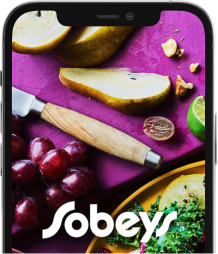From crisp zucchini to rich, earthy pumpkins, squash is a family of vegetables that has a uniquely wide range of flavour profiles, textures, and uses. Squash can be a key ingredient or a complement to savoury dishes, satisfying salads, sweet treats, and even hot or cold beverages. This squash 101 guide demystifies common types of summer and winter squash and gives you the basics on selection, prep, uses, and storage.
Summer versus winter squash
There are two squash varietals, summer and winter. Each harvest produces notably different varieties. One of the key differences is the rind.
Summer squash is harvested before fully maturing, (June through August) giving it a soft, edible skin. While tender and delicious, the delicate exterior gives summer squash a much shorter shelf life.
Winter squash, on the other hand, is harvested in autumn and has a distinct tough and (usually) inedible rind. On the inside, these varieties are rich, earthy, and packed with vitamins, minerals, and fibre.
It’s safe to say, whichever season’s harvest you choose, you’ll be getting a flavourful, nutrient-dense product.
Most common types of squash
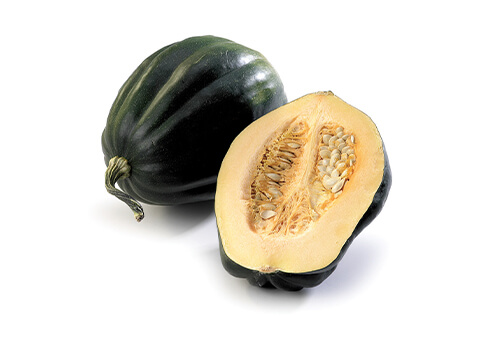
Acorn Squash
Named after its small, round acorn shape, this underrated everyday winter variety has an edible dark-green rind that slowly becomes orange throughout the ripening process. Acorn squash has a mild, sweet signature nutty flavour with a soft, almost mango-like texture, making it one of the heartier winter squashes.
How to choose Acorn Squash:
Look for a smooth, dry, crack-free rind that has no soft spots and feels heavy for its size (roughly one to two pounds.) If you can nick the skin easily with your fingernail, the squash might not be fully mature.
How to prepare Acorn Squash:
Wash the exterior, then using a paring knife, slice in half from stem to end. Acorn squash isn’t as tough as other winter versions, so you won’t have much trouble cutting through it. Scoop out the seeds (and save to roast for a snack later). Season and bake flesh side up at 190°C (375°F) for 45 to 60 minutes, or cook according to your own recipe.
Best uses: roasted, savoury dishes, sides, soups
Best paired with: honey, brown sugar, nutmeg, maple syrup, bacon, garlic, butter
Try:
This savoury side: Smoky Bacon-Wrapped Acorn Squash
As part of a festive holiday main: Maple-Cranberry Glazed Turkey with Spiced Acorn Squash
A unique twist: Acorn Squash with Harvest Rice Stuffing
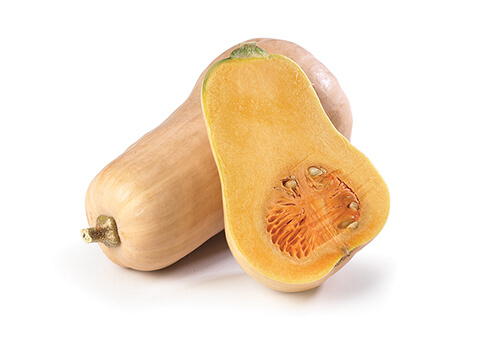
Butternut Squash
One of the most versatile winter varieties, the butternut squash has an iconic pear shape with a hard, pale inedible skin. Known for its distinctly sweet, rich, and nutty flesh, it’s most popularly used in soups but has potential to be added to virtually any savoury recipe. This winter staple can be roasted, puréed, or added to your favourite recipe for some cosy goodness.
How to choose Butternut Squash:
Look for a dark-beige matte skin with minimal bruising—and no green streaking, which can happen when it isn’t fully ripe. A pale spot on the squash is fine. Over- or under-ripened butternut squash can be dry and flavourless, so look for one that feels heavy and sounds hollow when you give it a tap with your knuckles. A stemless squash may indicate over-ripeness and a shorter shelf life.
How to prepare Butternut Squash:
For skin-off preparation, cut off the top and bottom so both ends are flat. Next, halve the squash where the thin end meets the bulbous side. Stand each half on a flat end and peel the rind until the orange flesh is revealed. Slice the thick half down the middle and scoop out the seeds (save for roasting, of course!). Now your base is ready to cut down to your desired shape and size.
For skin-on, cut both ends, halve lengthwise (carefully), scoop out seeds, season to your liking, and roast flesh side down at 204°C (400°F) for about 1 hour.
Best uses: soups, stuffed, desserts, roasted, mashed, puréed
Best paired with: cinnamon, nutmeg, rosemary, brown sugar, sausage
Try:
A classic appetizer: Creamy and nutty Butternut Squash Soup
A crispy, flaky tart: Herb & Onion Butternut Squash Tart
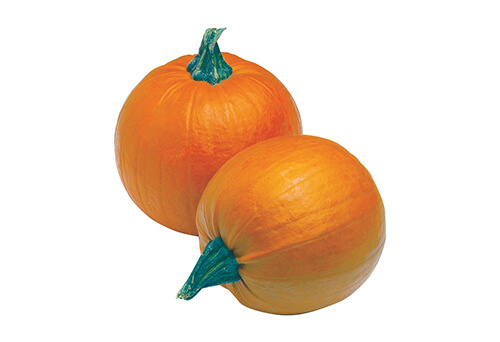
Pie Pumpkin
Of course, what would a guide to squash be without the beloved pumpkin. Although the pie pumpkin (or sugar pumpkin) is different from the traditional jack-o’-lantern, it does share a similar iconic “pumpkin” shape and bright-orange edible skin. Smaller, rounder, and firmer than the Halloween carving squash, the pie pumpkin has a notably earthy but sweet candy-like flesh that’s ideal for dessert bases like pies, tarts, and, you guessed it, lattes!
How to choose Pie Pumpkins:
Aim for a small, round, dense, and heavy pumpkin (roughly four to eight pounds), with a pale- to vibrant-orange rind. Skin finish ranges from shiny to dull, but look for one that has no visible bruising or soft spots and an intact dry brown stem.
How to prepare Pie Pumpkins:
After thoroughly washing the exterior, use a heavy-duty knife to puncture the top of the pumpkin. Carefully slide the knife down the centre from stem to bottom. Repeat on the opposite side and gently pull the halves apart. Now just scoop and save the seeds and you’re ready to take on any pumpkin recipe!
If roasting for purée, season the halves, roast flesh side down at 204°C (400°F) for 35 to 45 minutes, and scoop out the flesh with a spoon.
Best uses: desserts, beverages, soups, roasted, puréed
Best paired with: cinnamon, cloves, allspice, cream cheese, brown sugar, pecans
Try:
A unique, refreshing lunch: Pumpkin, Arugula & Quinoa Salad
An inventive way to use pumpkin in this main: Spiced Pumpkin Linguini
A rich and creamy dessert: Pumpkin Swirl Cheesecake Squares
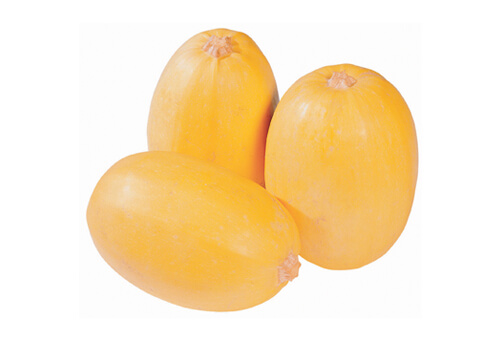
Spaghetti Squash
With a light, stringy flesh and an inedible pale-beige skin, this summer squash is ideal as an alternative to pasta. Spaghetti squash has a mild and slightly sweet-tasting flesh, making it the perfect base for flavourful sauces and spices.
How to choose Spaghetti Squash:
You’ll want to pick a weighty, firm squash with its stem intact, just as with other winter squash. The rind should be golden to dark yellow and pass the fingernail test. Avoid squash that has cracks, bruises, or tender spots.
How to prepare Spaghetti Squash:
After washing, use a large, sharp knife to carefully cut the squash lengthwise and remove the seeds. The most popular method of preparation is noodles. To achieve that stringy texture, season the flesh, bake cut side down at 190°C (375°F) for 45 to 60 minutes, or microwave for 12 to 15 minutes in a dish with 5 cm (2 in.) of water. Lastly, scrape out the “noodles” with a fork and add to your recipe!
Best uses: substitute for noodle dishes, stuffed with your favourite ingredients
Best paired with: Parmesan, pork, eggs, tomatoes, garlic, parsley
Try:
Our in-depth guide to perfectly roasted spaghetti squash
An upgraded main: Baked Chicken Parmesan with Spaghetti Squash
A family-friendly side: Spaghetti Squash Curry Rosti

Zucchini
This common everyday squash is perfect for both savoury and sweet dishes and can be eaten cooked or raw. Zucchini is known for its slim oblong shape and green, yellow, or multicoloured edible skin. Being one of the most versatile summer varieties, zucchini has an off-white, delicate, and mild flesh that takes on added flavours easily.
How to choose Zucchini:
Zucchini should be plump with no visible bruising, scratches, or dents. Ideally, it should also have some weight to it. Smaller zucchini has less water content, which may be better suited for certain recipes. Choose zucchini that is bright in colour and smooth-skinned with little surface texture.
How to prepare Zucchini:
Gently wash thoroughly and toss the stem. You can keep the skin on for added nutrition, but it can also be peeled. It can be shaved into ribbons for salad, turned into zoodles (zucchini noodles), cut into slices for grilling spears as fries, chopped down into bite-size pieces for sautéing and roasting, or grated for desserts and fritters.
Best uses: noodle substitutes, carb substitutes, salads, desserts, baked, roasted, sautéed, grilled
Best when paired with: Parmesan, breadcrumbs, goat cheese, basil, salmon, chocolate
Try:
This quick and light sauce: Zucchini & Spinach Pesto
A comforting, rich, and creamy tart: Zucchini & Goat Cheese Tart
A simple satisfying side: Grilled Zucchini with Herbs & Parmesan
Other types of squash:
Kabocha: Also known as the Japanese pumpkin, kabochas have a deep-green rind and sweet orange flesh.
Chayote squash: This historic summer squash dates back to the 1800s and features a mild, crunchy versatile flesh.
Buttercup squash: Wintery, sweet, and creamy, it has a pumpkin-like flavour.
Squash blossoms: Like a cherry on top, squash blossoms are an edible flower that the summer and winter vines produce and it can be stuffed, fried, or used in salads.
How to store squash
How to store summer squash
To maintain summer squash’s freshness, refrigerate immediately in a plastic bag and only wash when ready to be eaten. The summer variety lasts roughly five to seven days in the fridge, but it can also be frozen for up to 12 months (cut into pieces, blanch in boiling water for three minutes, and freeze in bags or a freezer-safe container).
Summer squash that has gone bad will turn soft and discoloured and may have an off-putting odour.
How to store winter squash
Winter squash is best stored in a cool, dark place, rather than the fridge, as refrigeration can change its flavour and texture. Raw uncut squash can live for up to three months in your pantry or cold room.
You’ll know it’s time to toss a squash when it’s soft to touch and beginning to leak juice.
Raw winter squash tends to not freeze, but for long-term storage, freeze cooked squash for six to eight months to enjoy cozy winter veggies well into spring!




